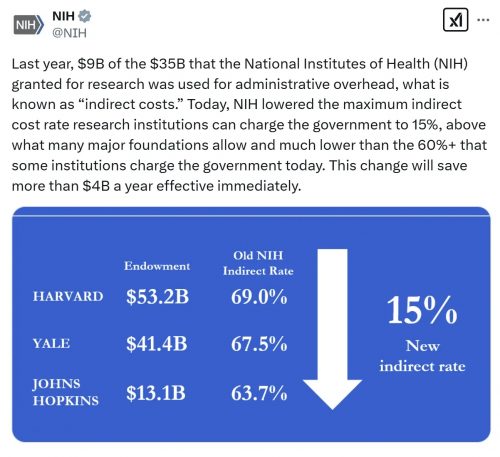Nature has noticed that the United States is destroying its research infrastructure. The Trump administration is blocking research grants by hook and crook.
bout a month after Donald Trump took office as the 47th US president, almost all grant-review meetings remain suspended at the US National Institutes of Health (NIH), preventing the world’s largest public funder of biomedical research from spending much of its US$47 billion annual budget.
These review panels are suspended because the Trump administration has barred the agency from taking a key procedural step necessary to schedule them. This has caused an indefinite lapse in funding and led scientists to make difficult decisions about the future of their research programmes.
The Trump administration issued an order on 27 January freezing payment on all federal grants and loans, but lawsuits challenging its legality were filed soon after, placing the order on hold. The fact that payments still aren’t going out because Trump’s team has halted grant-review meetings is exploiting a “loophole” in the process, says Aaron Hoskins, an RNA biochemist at the University of Wisconsin-Madison who has had to reconsider hiring graduate students because of a frozen grant application. “It’s really quite nefarious.”
Getting a research grant has never been a process of pushing a button and the cash pops out. Writing grants is an arduous process, and after you submit it, the NIH brings in a large team of scientists from a relevant field to read them and review them and make comments and rate the proposal. It’s a big deal, and it’s not a process that can be bypassed. The trick they’re pulling is to prevent the NIH from scheduling review meetings, so the money is all bottled up. It’s devious and dishonest. Illegal, even.
Some legal scholars say this ‘backdoor’ approach to freezing funding is illegal. That’s because the US Constitution gives Congress, not the president or his team, the power to appropriate funds, says David Super, an administrative-law specialist at Georgetown University Law Center in Washington DC. Blocking “advisory-committee meetings that are legally required to make payments is no different in effect than simply refusing to sign contracts or issue checks”, he says.
My fellow Americans — we all remember those grade school civics classes, where we all learned about the tripartite division of powers, checks and balances, all that bullshit that Trump just ignores. Maybe we should try enforcing those principles?
How about marching on the state? Stand up for science!
March 7. We all need to get out there and make some noise. I can’t make it to the national event in DC, but there are local events all around the country, look up your nearest rally site. I’ll be in St Paul at noon that Friday!
Will I see you all there?















